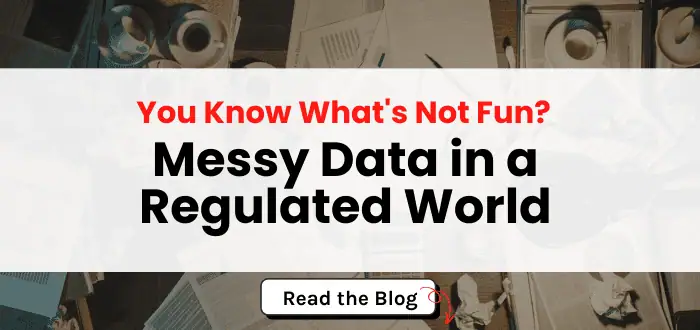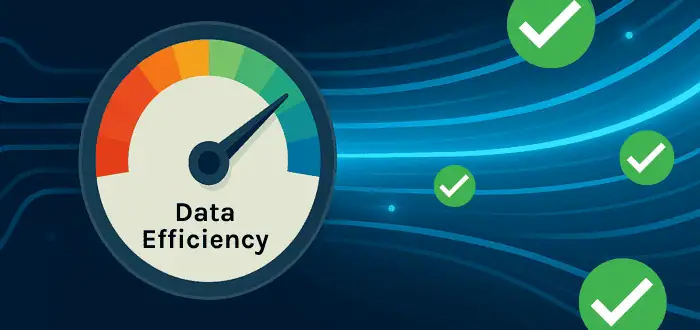October 23, 2024
The ROI of Data Cleansing
How a small investment in Salesforce data cleansing tools can make a huge impact on your business

You may think Salesforce data cleansing requires a huge investment in technology and a big chunk of time (and some magic) to turn your Salesforce org into a lean, efficient, lead-nurturing, sales-producing machine.
The truth is, you already have what you need: you have data.
In fact, you probably have data you didn’t even know you had. Data that holds valuable information like which marketing campaigns bring the highest quality leads or which customers are prime candidates for upsell opportunities. Your data could even help identify internal processes that could be made more efficient.
If you find yourself second-guessing Salesforce reports, sifting through duplicate records, or struggling to make business decisions based on data that is spread out across many systems, there’s likely an underlying issue.
The quality of your CRM data is the likely culprit. It’s preventing your data from bringing value or providing key insights. You’re stuck trying to make sense of something that makes little sense.
You need a way to transform dirty data into high-quality data. Data that is more useable, trustworthy, and easier to digest.
That’s where data cleansing comes in.
What is data cleansing?
Data cleansing isn’t a radical idea. Ask any business executive if they want more actionable, reliable customer data and they’ll respond, "Absolutely!"
The way to get there is by doing things like deduplicating, updating, transforming, consolidating, and integrating data. After all of that is accomplished, maintaining high quality data on a consistent basis is equally important.
If you want to accelerate revenue and improve processes, you need to break out of the old mentality that says data cleansing is either for sophisticated IT teams or for companies that have big budgets to invest in highly technical enterprise software. And you can’t allow yourself to believe it’s not worth the time when you’re already busy with so many other operational needs.
Because today, with the right data cleansing tool, it requires neither a dedicated IT team, technical software, nor excessive amounts of time. Data cleansing doesn’t have to be complicated and overwhelming. Nor does it take that much time and money.
Why is data cleansing important?
According to Salesforce, poor data quality costs businesses on average 30 percent of their revenue a year (source). But these costs are not just financial. Bad data costs companies a loss in terms of reputation and missed opportunities, and it can lead to erroneous and costly decision-making.
If data cleansing is inevitable and critical to avoid the negative consequences of poor data quality, why do companies put it off or fail to do it at all? Oftentimes it’s because key decision makers, and perhaps even yourself, have trouble seeing the benefits that good data hygiene can bring. They’re not convinced that something simple like merging duplicate records will have a profound effect on the bottom line, so why dedicate time, money, and resources to the cause?
The truth is that the value derived from data cleansing can feel abstract. It’s hard to quantify in terms of actual dollars saved, and it’s different for every business.
However, there are several key benefits your company will gain from clean, high quality Salesforce data that make a huge impact.
In this article, we will look at a few positive outcomes our customers have seen within their own companies once they took action to clean up their data.

12 Proven Benefits of Data Cleansing
1. The ability to make smarter, more accurate business decisions
Poor quality data quickly skews reports and analytics, causing decision-making to be extremely difficult. Imagine running a forecasting report, only to find the numbers inflated due to duplicated records.
In contrast, clean data fosters an environment where stakeholders have confidence in the data. They have better insights, accurate metrics, and easier to digest data.
Business decisions need to be based on facts, not hunches. That’s why it’s critical to dedicate time and resources to ensure the data you work with is of high quality.
2. Cultivate a more productive and efficient workforce
Without the ability to easily identify the right accounts, sales and marketing teams become inefficient. They waste time calling and emailing prospects who may not be the right candidates. Or worse they miss an important opportunity by mistaking prospects for existing customers.
A clean database means less time is spent checking, validating, and digging through duplicate records to find the right information. It can mean no more bad or malformed emails on email campaigns or invalid addresses on physical mail campaigns.
Overall, employees don’t have to backtrack because of mistakes. Everyone saves time when they don’t have to double-check results or fix errors caused by poor data.
3. Enhance marketing campaigns and sharpen sales strategies
Effective marketing and sales campaigns depend on both the quantity and the quality of the data.
Data gives marketing and sales teams the power to understand who their customers are – their needs, wants, expectations, and buying behaviors – all necessary information for successful marketing campaigns and for driving purchases.
Optimizing the quality of marketing and sales data will in turn, optimize the quality of the insights they generate, thus increasing the bottom line.
4. Gain greater visibility and insights into what works (and what doesn’t work)
When data is clean you have less dysfunction and greater visibility into your entire organization.
Whether a lack of visibility is caused by a convoluted mess of dirty data, siloed datasets, or both, it can have a profound effect on your ability to spot opportunities for your business. You’re likely to run into big stumbling blocks for growth.
An environment with greater data visibility can give your company a lot of insights, both internally and externally. It can reveal problems with your current workflows, ways to improve upon processes, and areas than can be made more efficient.
With these insights you can find ways to standardize and streamline processes, potentially saving you a substantial amount of time and money.
5. Save money and reduce waste
A long-standing theory among data experts is the 1-10-100 rule. The rule states that it costs $1 per record to prevent poor data quality, $10 per record to clean and dedupe later, and $100 per record if no data quality practices are implemented. In other words, the longer data quality is ignored, the more costly it becomes.
Part of improving data quality is addressing outdated info. Data decay is unavoidable as people’s lives change and companies go out of business or merge.
Deleting or archiving records that have been dormant for a period of time not only contributes to better data quality, but it saves money on CRM and marketing automation subscription fees.Updating and validating mailing addresses could save you money on wasted printing and postage.
Besides monetary costs, there are also opportunity costs associated with poor data quality. Consider the role data plays in marketing campaigns, sales intelligence, forecasting goals, and customer experience metrics. Or how much time is wasted when calls are made to bad phone numbers.
A bounced email or duplicate record here and there may not seem like a big issue, but overtime the ripple effects could significantly cost your business.
6. Improve customer relationships while making customers happier
It’s no secret that superior customer service is more important than ever for businesses today. Buyers are more likely to remain loyal to companies based on the experience they receive rather than on price or product.
But in order to succeed at this, you need to understand who your customers are. The only way to do that is by collecting valuable insights and using that data.
This is where data quality becomes important.
When data is clean, you’re able to build a detailed customer profile to target the right buyers and track customer habits. Unique, nonduplicated records mean you can see all touch points from presales, after-purchase follow ups, and customer service communications. Clean data also prevents duplicate touchpoints that can irritate customers.
Tying high quality data with your customer experience will attribute to higher engagement and conversation rates, increased renewal and lower attrition rates, cross-sell and upsell opportunities, a better brand perception, and more loyal customers.
How to get started cleaning your data
Addressing data quality issues should not be made an afterthought because poor data quality has a snowball effect. What starts out as a small data quality issue, like a duplicate record here and there or outdated info can become a much larger problem.
It’s critical to invest time, money, and resources to improving and maintaining data quality now rather than later.
Fortunately, there are data cleansing tools made specifically for Salesforce that make the process quick and easy.
A good data cleansing and management tool should be flexible, easy to use, and give you the ability to:
- Set up and implement out-of-the-box with no need for IT involvement
- Make configurations that satisfy your unique needs
- Automate data cleansing tasks with little to no manual work
- Integrate and sync data from multiple sources
- Collaborate and divide up tasks with multiple users
- Audit and view historical reports to monitor your progress
Optimizing Salesforce data requires a little heavy lifting upfront (after all, it’s not a "one size fits all" approach), but it comes with a huge payoff.
When your Salesforce data is clean and routinely maintained, your team will have the power to improve processes. They’ll be equipped to make more proactive and strategic decisions. And they’ll be able to better serve customers overall.
Before you know it, you’ll gain insights you didn’t know you were missing. And such clarity can transform your organization and usher in a new era of business growth.






